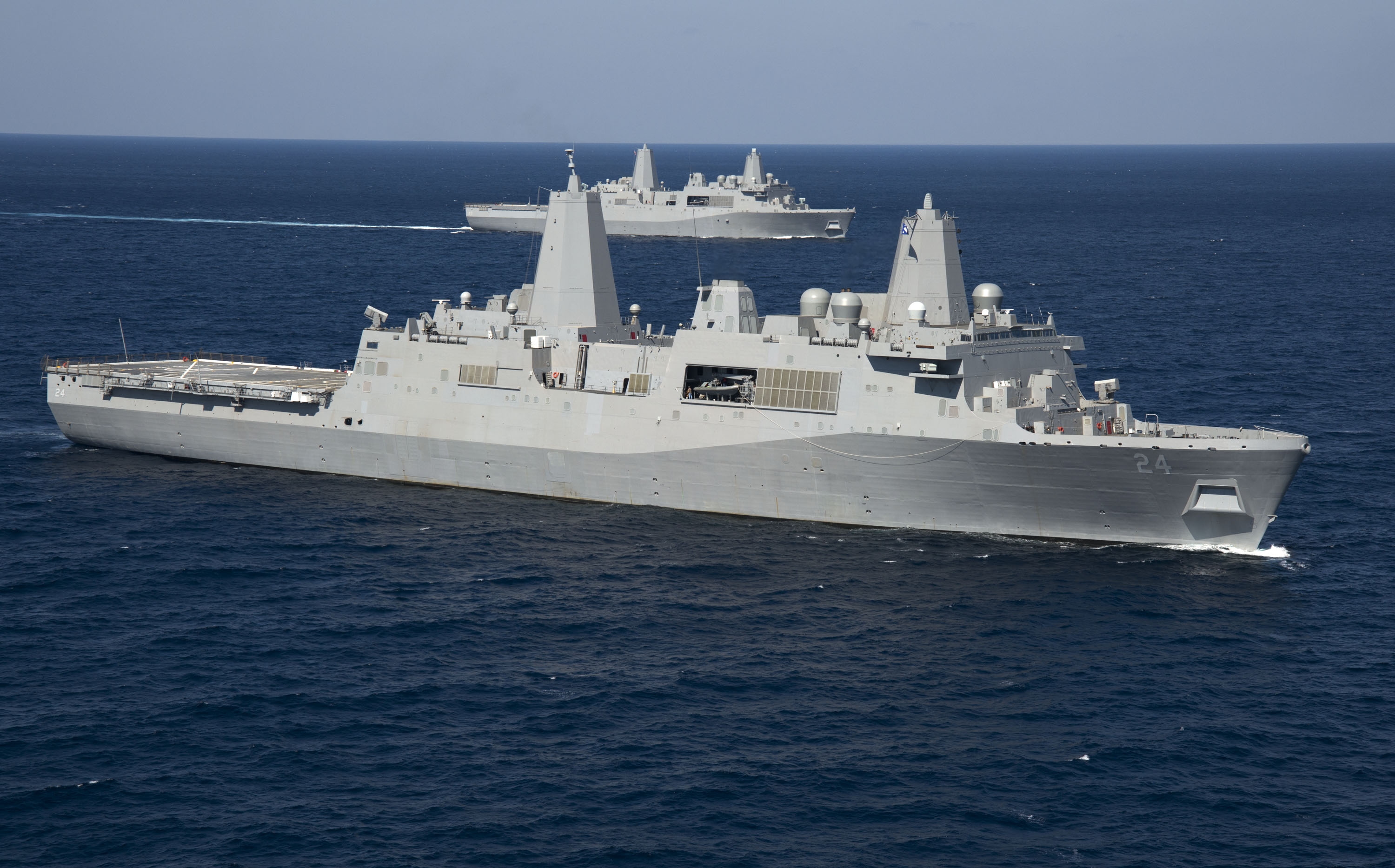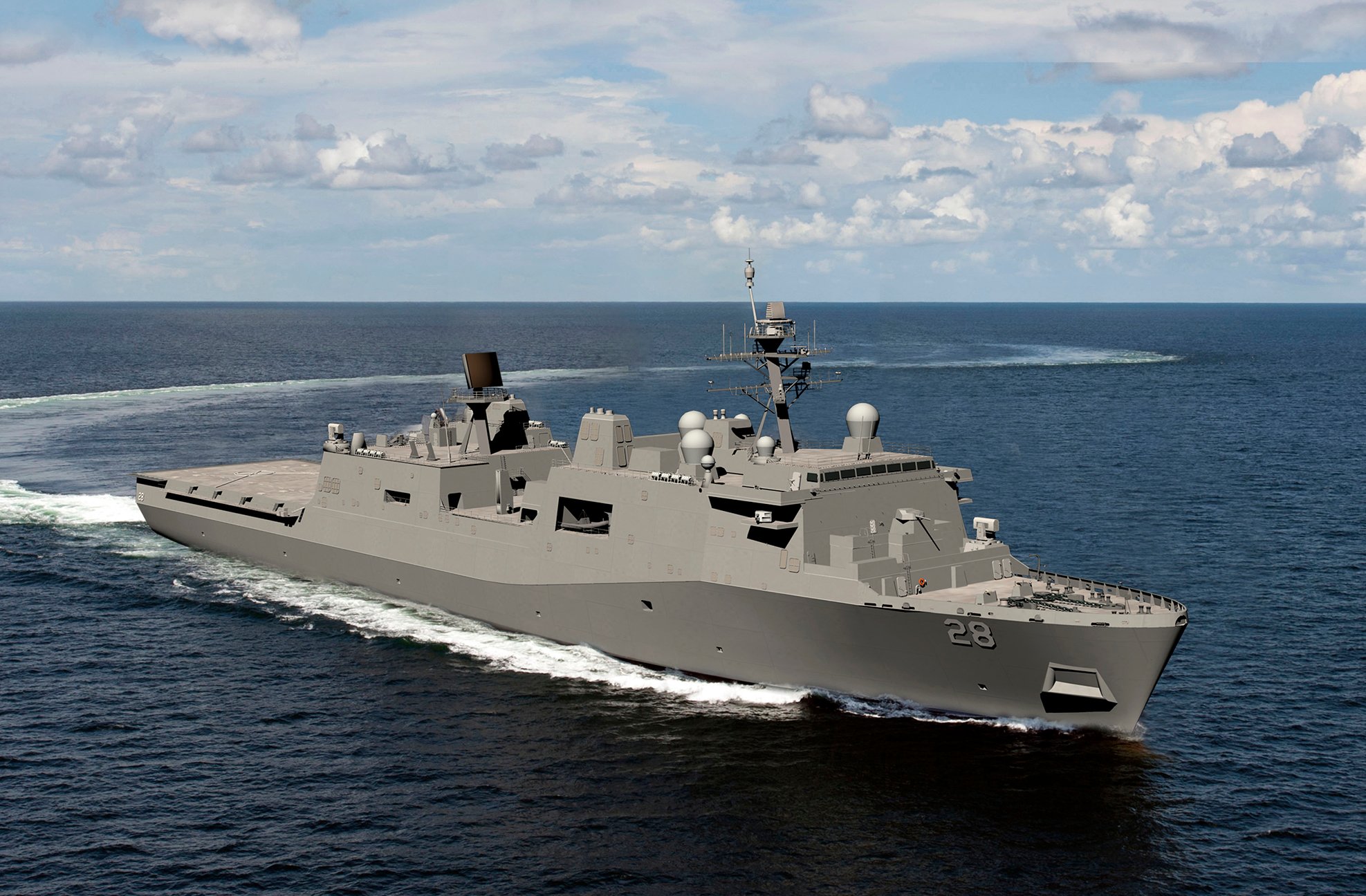
WASHINGTON, D.C. – After this week’s 2018 budget request rollout it is still unclear if the Navy will use the $1.8 billion it was given recently to buy a 13th San Antonio-class amphibious transport dock ship (LPD-17) or if it will move straight to the next-generation LX(R) dock landing ship. But Navy leadership assures it is committed to keeping the transition from the LPD to the LX(R) derivative on track.
The service’s San Antonio-class amphibious transport dock (LPD-17) class had previously been set to end at 11 ships, with hull LPD-27. However, once it was selected to serve as the design inspiration for the LX(R) dock landing ship replacement the service decided shipbuilder Ingalls Shipbuilding needed to keep a hot production line and added an LPD-28 in Fiscal Years 2015 and 2016. With production moving along so quickly, it was deemed that yet one more ship would be needed to fully bridge LPD construction to the start of the LX(R) program, and in the Fiscal Year 2017 spending plan lawmakers provided $1.8 billion for LPD-29, the 13th ship in the class.
However, the Navy’s FY 2018 request and associated budget justification books make no mention of the funding from FY 2017 or the possibility of buying a 13th ship – though, due to the FY 2017 spending bill being passed so close to the 2018 budget rollout, Pentagon officials acknowledged this week that not all the budget support materials had been updated to reflect actual 2017 spending levels.
Despite that lack of acknowledgement or requests for any remaining funding needed to complete the ship, Acting Navy Secretary Sean Stackley’s written testimony for a May 24 Senate Appropriations defense subcommittee hearing states, “this Navy continues to build toward a 34-amphibious ship force by FY 2022. The appropriation by Congress for LPD 29 in FY 2017 supports both amphibious lift requirements and the industrial base. In conjunction with the Navy’s FY 2016 award for the LHA 8, the Fleet oiler (TAO 206), and LX(R) design, LPD-29 provides for an effective transition to LX(R) in FY 2020.”
Asked about the disconnect between Stackley’s written testimony and the lack of mention of LPD-29 in the budget request, Chief of Naval Operations Adm. John Richardson told USNI News after the Senate hearing that 2018 was not about growing the fleet. He repeated the official line that Pentagon leadership instructed the services to “consolidate the foundation this year, get balanced, get whole, and then look for the strategic review this summer and we’ll see how it all fits in.”
“Right now we’re still looking at a requirement for more of those amphibious ships,” Richardson continued.
“We’d like to get the LX(R) moving as quickly as we can, that has to be consistent with a mature design and all those things that really kind of guarantee shipbuilding success. So I think that that will be a dynamic conversation this year.”

The Navy has five years to spend the $1.8 billion currently appropriated for LPD-29. Asked if that money could be used to accelerate LX(R) instead of buying a 13th LPD, Richardson said he didn’t want to speculate on possibilities but “in terms of sort of a general direction we want to move in, that’s the direction we want to go.”
CNO confirmed the industrial base – in this case, Ingalls Shipbuilding as the sole amphibious ship builder – is “capable of building more ships, it’s just a matter of the resources.”
Much of the Navy’s plans to build to a newly identified 355-ship requirement are on hold for now, pending the results of Defense Secretary James Mattis’ defense strategy review, which USNI News understands has already begun and should wrap up sometime this summer. Pending the results of that review, the Navy has declined to project out its shipbuilding plans beyond the FY 2018 budget request, with multiple officials saying during the May 23 budget rollout that any projections for 2019 and beyond are simply placeholder figures.
Still, a few things are known about the upcoming buildup – one of them being that these amphibious ships will play a role. The Marine Corps declared in 2009 that it required 38 ships to support a two-Marine Expeditionary Brigade-sized forcible entry capability. The Marines and Navy identified 33 as a resource-constrained goal, but the Navy struggled to top 30 amphibs for a while. Stackley’s testimony notes the Navy will get to that 34 figure in 2022, but the demand for amphibs has only grown since then. Marine Corps leadership regularly notes it would need more than 50 amphibs to meet combatant commander demands for expeditionary forces around the world. With a hot production line, and the potential for Ingalls Shipbuilding to construct both LPDs and LX(R)s side by side if the Navy chose to expand the San Antonio class while beginning its LX(R) construction, these amphibs are certain to play a role in the upcoming fleet expansion.
Though avoiding a production gap between LPD and LX(R) production will be important for the Navy and Ingalls Shipbuilding to work out, another ship to support Marines afloat will see a break in procurement, which the Navy says won’t cause any damage to the program. During a May 24 House Armed Services seapower and projection forces subcommittee hearing, several congressmen asked about the Expeditionary Sea Base (ESB), formerly called the Afloat Forward Staging Base. General Dynamics NASSCO in California builds these ships, the fifth of which the Navy has already bought but the yard has not yet begun building. Acting Navy acquisition chief Allison Stiller said at the hearing that the Navy would not buy any more ESBs just yet, while the Navy and Pentagon figure out where the class of Military Sealift Command-operated ships fit into future expansion plans. She made clear that a break in ESB production would not harm the yard – it has a sufficient backlog of work, between ESB-5, work on the oiler program and commercial shipbuilding work – even though production breaks are a concern for the LPD-to-LX(R) and Littoral Combat Ship-to-frigate upcoming transitions in the Navy.





